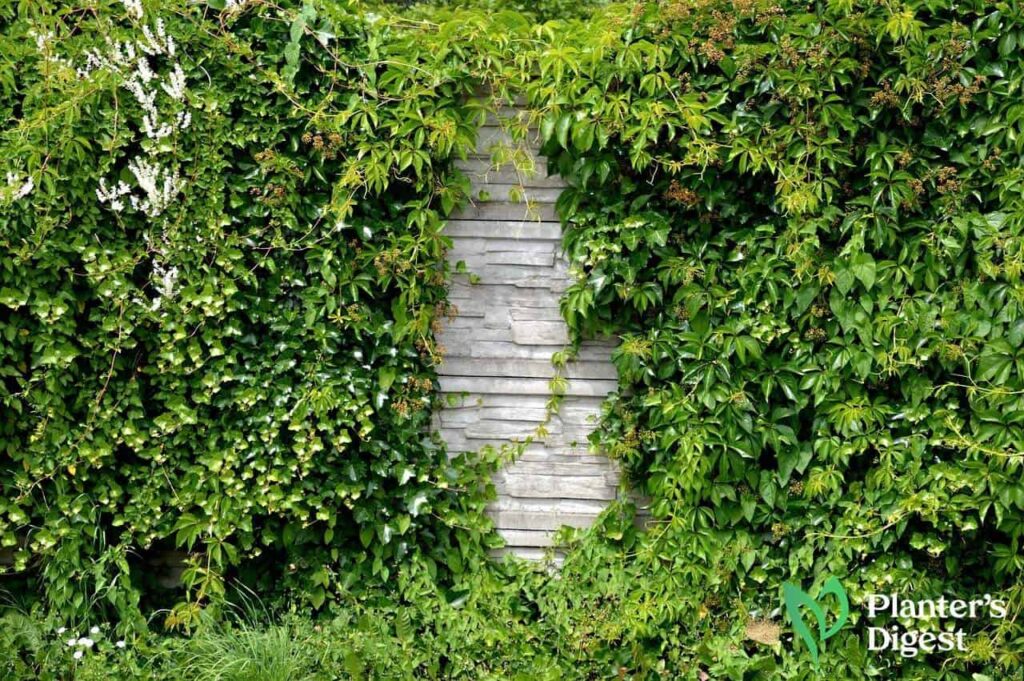Gardens serve as a peaceful oasis amid the hustle and bustle of life and the city. But this ambiance is quite challenging for those living near a busy road.
In this article, we listed the most effective ways to drown down road noise in your garden and other tips on creating a pleasant soundscape. Let’s get started!
How to Reduce Road Noise in Your Garden
Add walls and fences
Walls and fences are an effective way to reduce road noise in your garden. To increase effectiveness, you should place the wall or fence near the noise source.
Generally, the taller the wall, the more noise it can reduce. Here’s a table comparing wall heights and their noise-reduction capabilities.
| Wall Height (in feet) | Noise Reduction (in decibels) |
| 8 | 10 |
| 10 | 15 |
| 12 | 20 |
| 14 | 25 |
| 16 | 30 |
Don’t forget to check with your village association or local assessor on rules about property lines before building a wall or fence. You’ll be creating a border, so make sure it’s within the bounds of your property, or else it might be taken down or removed.
Once they’re properly built, keep your wall or fence in good condition. Remember, sound is a form of energy that can flow through cracks or holes, so regular maintenance will go a long way in preventing noise from entering through those cracks.
Let’s take a look at the different types of walls and fences you can build in your garden to reduce noise.
1. Brick or Stone Wall
A brick or stone wall is an excellent piece to deflect sound away from your garden because of its robust, durable form and high density.
Generally, a brick or stone wall should be 8 feet high to reduce noise up to 10 decibels from cars on nearby roads.
Another advantage of using brick or stone walls is that they are not prone to rotting, unlike wood, and can withstand natural disasters like earthquakes. So, with brick or stone walls, you’re sure they can hold up for many years.
However, building these walls can be expensive, labor-intensive and time-consuming, so make sure you follow the rules and build them in the right place to avoid breaking them down in the future.
2. Wooden Fence
The standard size for wooden fences is 6 feet tall and 8 feet wide, which gives you enough privacy while drowning out road noise. It’s also easier to install and cheaper than brick and stone walls.
You can build a wooden fence in two ways – with spaces like a picket fence or without spaces like a stockade fence.
A picket fence is usually cheaper but may not be as effective as stockade fences in deflecting sound because of the spaces between wood.
On the other hand, a stockade fence is more expensive to build but, at the same time, more effective in reducing road noise in the garden.
Once you build a wooden fence, consistently maintain it to prevent rotting, cracks and holes, which can weaken its noise-reduction capabilities.
3. Vinyl Fence
Vinyl fences are easy-to-install solid panels that can effectively drown out traffic noise in your garden. Although they cost more than wooden fences, they won’t require much maintenance after installation because they’re rot-resistant and long-lasting.
4. Metal Fence
A sheet of metal fence panels with no holes can also reduce traffic noise. Steel metal fences are stronger but more expensive, while aluminum metal fences are lighter and cheaper but may need to hold up better against tree branches.
You can also use chain link fences as walls. Just grow vining plants like the English ivy along the chain link to help absorb road noise.
5. Acoustic Fence
An acoustic fence can reflect, deflect and absorb noise and reduce noise levels by 28 decibels. It’s a standalone structure, usually ⅛ inch thick and six by 30 feet per piece, that you can put in your garden to reduce road noise.
6. Trellis
A trellis is a freestanding lattice structure for plants to climb on. A 6-foot trellis will help reduce road noise in your garden once the plants grow entirely along it.
Some common vining plants that you can use in your trellis are grapes, tomatoes, squash, roses, jasmine, honeysuckle or wisteria plants.
Put in trees and shrubs
Trees and shrubs are a natural and visually-appealing way to reduce road noise in your garden.
Generally, the best plants, shrubs and trees for noise reduction should be at least 6 feet tall with thick foliage.
Evergreen plants are an excellent choice for noise reduction because they keep their leaves for most seasons. They also grow thicker than other species to absorb more noise.
You should plant these trees or shrubs close together to form a hedge wall without openings for unwanted noise. Afterward, you can plant them in more than one row to increase the overall density of your noise barrier.
Here’s a table of the best plants, trees and shrubs for noise reduction:
| Common Name | Genus | Height | Distinct Feature/s |
| Arborvitae | Thuja | 30 to 60 feet | • Scale-like leaves • Pyramidal habit |
| Cypress | Cupressus | 20 to 60 feet | • Grows cones • Scale-like leaves |
| Holly | Ilex | 10 to 30 feet | • Spiny leaves • Red or black berries |
| Juniper | Juniperus | 10 to 60 feet | • Scale-like leaves • Conical shape |
| Spruce | Picea | 50 to 150 feet | • Needle-like leaves • Pyramidal habit |
Add water features
If you don’t want to hear road noise, why not change it to the calming and relaxing sound of running water?
Create a soundscape in your garden by placing water features like fountains, waterfalls and fishponds. This natural sound will drown out traffic noise, mask other noises, and keep them out of your ears.
Factors to Consider in Reducing Noise in Gardens
For effective noise reduction in gardens, there are several factors you’ll need to consider. Let’s discuss each one in more detail!
Acoustic Treatment Methods
There are three ways that you can reduce noise: by deflection, absorption or energy conversion.
When we look at traffic noise, it naturally moves and varies in decibel levels, speed, frequency and power. Additionally, sound waves spread in all directions and act differently because of weather or interaction with objects.
So, whichever of these three acoustic treatment methods you choose, you must think bigger, longer and broader than the current need. A basic approach would be to block your line of sight and add a little more height to block road noise more effectively.
Now, let’s take a look at the different acoustic treatment methods.
1. Acoustic Deflection
Acoustic deflection means reflecting noise in the opposite direction. You can apply this in your garden by installing a high perimeter wall or fence, which will bounce back the road noise where it came from.
2. Acoustic Absorption
Acoustic absorption pertains to the process in which the object takes in the sound energy and reduces the sound pressure, power and spread altogether. You can achieve this in your garden by planting thick shrubs absorbing sound waves from the road.
3. Acoustic Energy Conversion
Acoustic energy conversion involves an isolation membrane, which converts sound to heat energy. When the sound waves come in contact with the membrane, it creates a friction effect converted to heat.
Noise Barrier Properties
Reducing road noise in gardens depends on noise barrier properties such as height and length, density, coverage and placement. Let’s discuss each property and how you can use them to drown out the noise in your garden.
1. Barrier Height and Length
Generally, the higher the barrier, the more noise is blocked or deflected.
A good starting point is to cover your line of sight and then add an extra height above that. This increased height will prevent as many sound waves from entering your garden.
2. Barrier Density
A dense barrier will reflect or absorb more soundwaves since the mass of this barrier will slow down the soundwave instead of letting it pass through. For instance, a hedge should be more than 7 meters deep to reduce noise effectively.
Here’s a table on the noise reduction capabilities based on barrier density.
| Barrier Density (kg/m²) | Noise Reduction (in decibels) |
| 10 | 10 |
| 20 | 15 |
| 30 | 20 |
| 40 | 25 |
| 50 | 30 |
3. Barrier Coverage
Barrier coverage also affects the amount of sound energy the object or material can block. The more complete the barrier coverage is, the fewer sound waves can pass through the barrier.
The common culprits for reducing barrier coverage are gaps, cracks or holes. So, cover your noise barriers as much as possible since even the tiniest gaps can reduce their effectiveness in blocking sound.
Check out the table comparing noise reduction capabilities based on barrier coverage.
| Barrier Coverage (in percent) | Noise Reduction (in decibels) |
| 100 | 10 |
| 75 | 7.5 |
| 50 | 5 |
| 25 | 2.5 |
| 0 | 0 |
4. Barrier Placement
Location is a crucial part of reducing noise in gardens, and noise barriers should ideally be at the perimeter boundary of your garden, close to whatever is causing the noise.
The rule is that the closer the barrier to the noise source, the more effective it is in reducing noise levels.
Here’s a table on noise reduction capabilities and barrier placement.
| Barrier Placement (in meters) | Noise Reduction (in decibels) |
| 1 | 10 |
| 2 | 7.5 |
| 3 | 5 |
| 4 | 2.5 |
| 5 | 0 |
FAQs on Reducing Road Noise in Garden
Noise pollution refers to excessive and unwanted sound that harms the environment and causes health problems such as hearing loss and stress.
According to the World Health Organization, residential areas should have noise levels not exceeding 55 decibels during the day and 45 decibels at night.
Evergreen trees and shrubs are excellent road-noise-reducing plants because their dense foliage helps block or absorb sound waves. Some evergreen species for noise reduction are arborvitae, spruce, juniper and cypress trees.
The leaves and stems of plants absorb and deflect sound energy. When sound passes through the plant, the waves bend around the plant structure and reduce the sound intensity until no energy is left to vibrate air molecules.
Fake plants do not absorb sound waves like natural plants because they lack the waxy layer that helps leaves and stems trap sound waves. However, they can still reduce noise by acting as a physical barrier.
Wood can absorb sound because of its porous and dense structure. As a result, once sound passes by wood, it can reduce its echo, reverberation and amplification.





